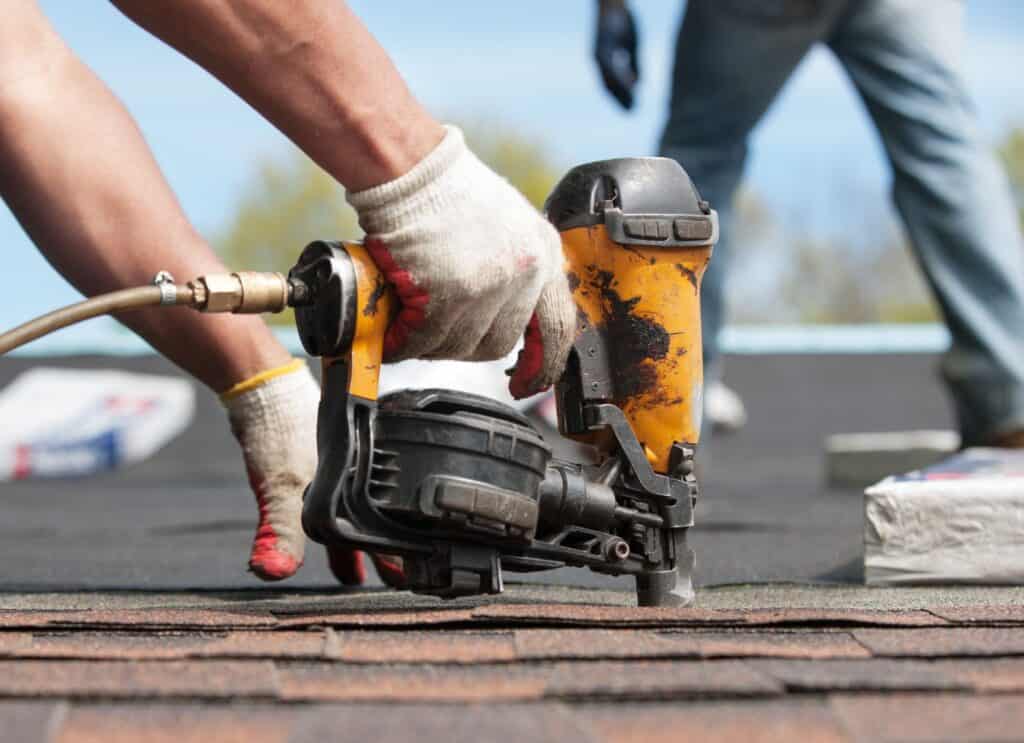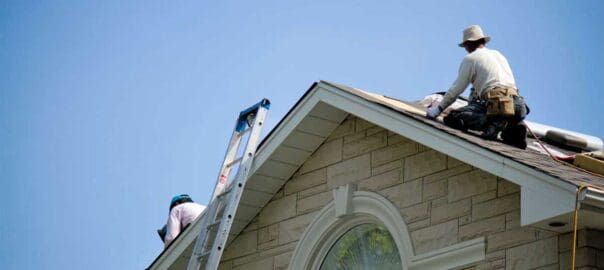If you’re a homeowner in Colorado, you’ve likely experienced the wild and unpredictable weather that can change on a dime. One minute, it’s sunny and pleasant, and the next, hail the size of golf balls is coming down like it’s auditioning for a role in the next Twister movie. It’s no wonder that protecting your home from hail damage is a top priority—especially your roof, which takes the brunt of the storm.
That’s where architectural shingles come in. Class 4 IR (Impact-Resistant) roofing is ideal for areas prone to hail impact. This is where the importance of selecting the right roofing system comes in.
These roofs are designed to withstand the pounding hailstorms that are thrown at them. But how do you know if your roof is up to the task? If you’re wondering whether you have a Class 4 IR roof or if it’s time to upgrade, you’re in the right place. This guide will identify whether your roof is Class 4 IR, what makes it “impact-resistant,” and which materials are generally considered Class 4-rated.
Let’s start by determining whether your roof is a hailstorm warrior or needs reinforcement!

What Does Class 4 IR Mean Anyway?
Before identifying whether your roof qualifies as Class 4 IR, let’s quickly step back and explain what that means.
Class 4 IR (Impact-Resistant) refers to a specific rating given to roofing materials that can withstand the impact of large hailstones without cracking, breaking, or being severely damaged. Roofing materials are rated for impact resistance based on tests conducted by Underwriters Laboratories (UL), one of the leading safety testing organizations.
The Class 4 rating is the highest possible rating for impact resistance. Think of it like the “A+” in roofing material performance regarding hail protection. This means the material has passed the UL 2218 test, which involves testing how roofing materials handle hailstones up to 2 inches in diameter—more significant than most hailstones you’ll ever see in a typical storm. But hey, this is Colorado, where hail impact can be substantial. We’ve had hailstones the size of baseballs, so it’s good to be prepared!)
Class 4 IR roofing materials are built to be durable, weather-resistant, and protect your home in even the harshest weather conditions, including the occasional surprise hailstorm. This is why many insurance companies even offer premium discounts for homes with Class 4 IR roofing, as it significantly reduces the risk of hail-related damage. So, not only are you protecting your roof, but you could also save money on your insurance premiums. Win-win!
How Do I Know If My Roof Is Class 4 IR?
There are a few ways to determine if your roof is a Class 4 IR roof. Don’t worry; you don’t need a degree in roofing science to figure it out! Here are the most straightforward methods to determine if your roof qualifies as impact-resistant.
1. Check for the Manufacturer’s Label
If your roof is relatively new, one of the easiest ways to identify whether it’s a Class 4 IR roof is to check the manufacturer’s label or documentation. When a roof is installed, the manufacturer should provide documentation that outlines the product’s specifications, including its impact-resistance rating.
For example, if your shingles were made by companies like Malarkey Roofing, GAF, CertainTeed, or Owens Corning, the product information should indicate whether they have passed the Class 4 IR test.
Contact the roofer who installed the roofing product if you’re unsure where the documentation is. They should have a record of the materials used and can confirm whether they are Class 4-rated. Easy peasy!
2. Visual Inspection of Shingles
You can also visually inspect your roof shingles if you don’t have the manufacturer’s label. Class 4 IR shingles are typically Thinner materials that often provide higher impact resistance and are more durable than regular shingles. They are designed to withstand impacts and are built with reinforced materials.
For instance, Class 4 shingles may look slightly more textured or have a different finish than standard shingles. Some Class 4 shingles are made with modified asphalt or fiberglass, which gives them added strength and resistance to impact. You might notice that they feel more rigid or dense when you handle them than traditional shingles.
However, a visual inspection alone may not be enough to confirm whether your roof is Class 4, so it’s always a good idea to cross-check with the manufacturer or your roofing professional.
3. Have a Professional Roofer Do an Inspection
When in doubt, you can have a professional roofer inspect your roof. A qualified roofing contractor can assess whether your roof is Class 4 IR or recommend whether upgrading to a Class 4-rated roof is worth considering. Professional roofers can also tell you whether your roof is still in good condition or has suffered damage over time.
At Denny’s Roofing, we offer free roof inspections to help homeowners assess the condition of their roofs and determine whether they’re ready to handle the next hailstorms.

What Are the Benefits of a Class 4 IR Roof?
Okay, you can now identify if your roof is Class 4 IR. But why should you even care? What’s the benefit of this high rating?
Let’s break it down:
1. Protection from Hail Damage
The apparent reason to go for Class 4 IR roofing is hail protection. Colorado is notorious for unpredictable hailstorms, and even a golf-ball-sized hailstone can cause significant damage to roofs that aren’t adequately protected. With Class 4 shingles, you’re giving your home a serious layer of defense against hail, ensuring that your roof is less likely to crack or break during a storm.
2. Lower Insurance Premiums
Many insurance companies offer discounts for homes with impact-resistant roofs because they’re less likely to suffer hail damage. Depending on your insurer, the discount could range from 5% to 25%, adding to significant savings over time. If you live in a region prone to hailstorms (like Colorado), this is an excellent incentive to upgrade to a Class 4-rated roof.
4. Increased Durability and Longevity
Class 4 IR roofing is generally built to last longer than regular roofing materials. Since these shingles are designed to handle severe weather conditions, they’re less likely to suffer from wear and tear, which means your roof could last 10 to 20 years longer than a standard roof. This is especially true on the Front Range, which insurance companies nickname “Hail Alley.” Plus, they’re more resistant to other types of damage, including high winds, also common in Colorado.
5. Peace of Mind
Let’s face it: You don’t want to sit at home with a cup of coffee and suddenly hear the sound of hailstones pelting your roof. With Class 4 IR roofing, you can relax, knowing your home is protected. It’s like having an impenetrable shield for your home so you can stop worrying whenever the weather forecast predicts a storm.
What roofing materials can be classified as Class 4 IR?
Now, you’re probably wondering: What materials can be classified as impact-resistant shingles? The good news is that several roofing materials can be rated Class 4 IR, so you have options for building a hail-resistant roof. Let’s take a look at the most common Class 4 IR roofing materials:
1. Asphalt Shingles (Modified or Fiberglass)
Asphalt shingles are the most common roofing material in the U.S., and many impact-resistant asphalt shingles are rated Class 4 IR. These shingles are often made from fiberglass or modified asphalt, which gives them added durability and strength.
Examples: Malarkey’s Legacy and/or Vista, Atlas Pinnacle Impact shingles; GAF Armourshield II, CertainTeed’s Landmark IR shingles;
2. Metal Roofing
Metal roofs are incredibly durable and naturally resistant to hail damage. Whether you opt for a roof replacement or upgrade to class 3 materials, it’s essential to consider the level of impact resistance. Steel and aluminum can be components of some roofing products, or zinc; metal roofing provides excellent protection against hailstorms and is often rated Class 4 IR.
Examples: Standing seam metal roofs and Stone-coated steel shingles are known for their durability and aesthetic appeal.
3. Concrete and Clay Tile Roofing
While selecting a roofing system, it’s important to consider durability. Tile roofing (mainly concrete or clay tiles) is not as standard as asphalt; it’s another material that can be rated Class 4 IR. These tiles are naturally heavy and strong, making them an excellent choice for hail-prone regions.
Examples: Westile Tile, Boral Tile, and Ludowici clay tiles.
4. Synthetic Roofing Materials
Depending on the manufacturer, synthetic roofing materials like rubber, plastic, or composite shingles can also be Class 4 IR. These materials are designed to mimic the look of traditional roofing materials while offering enhanced durability.
Examples: DaVinci Roofscapes synthetic shingles.
Conclusion: Class 4 IR Roofing = Ultimate Protection
To wrap things up, if you live in Colorado, you already know that our weather can be fierce and unpredictable, especially when it comes to hailstorms. Installing a Class 4 IR roof is one of the best ways to protect your home from damage and ensure that your roof can handle whatever Mother Nature throws at it.
Plenty of Class 4-rated materials, from impact-resistant asphalt shingles to metal roofs and tile roofing. Whether you’re looking to upgrade your existing roof or install a new one, Denny’s Roofing is here to help you navigate your options and ensure you’re fully protected.
Want to know if your roof is ready for the next hailstorm? Call Denny’s Roofing for a free inspection today and learn how we can help you safeguard your home against Colorado’s wild weather!

Other Popular Questions Related to Shingle Roofs
Q: What is a Class 4 impact-resistant roof?
A: A Class 4 impact-resistant roof is a roofing system designed to withstand significant impact, such as hail, without damage. It is the highest rating for roofing materials under the UL 2218 impact test, indicating superior durability.
Q: How can I identify if my roof has Class 4 impact-resistant shingles?
A: To identify if your roof has Class 4 impact-resistant shingles, look for labeling or documentation from the manufacturer indicating a UL 2218 Class 4 rating. You can also consult a roofing contractor to inspect and confirm the type of shingles used.
Q: What is the UL 2218 impact test?
A: The UL 2218 impact test is a standardized test that evaluates the impact resistance of roofing materials. Roofing products are rated from Class 1 to Class 4, with Class 4 offering the highest resistance to impact from objects like hail.
Q: Why should I choose Class 4 impact-resistant shingles for my new roof?
A: Choosing Class 4 impact-resistant shingles for your new roof offers enhanced protection against hail and other impacts. Their durability could reduce the need for frequent roof repairs and lower insurance premiums.
Q: How do Class 4 roof shingles compare to standard asphalt shingles?
A: Class 4 roof shingles offer superior impact resistance compared to standard asphalt shingles. While they may have a higher upfront cost, they provide better protection and longevity, which can be cost-effective in the long run.
Q: Are Class 4 impact-resistant shingles suitable for all types of roofs?
A: Class 4 impact-resistant shingles are suitable for various roofs, including shingle and metal roofs. However, consulting with a roofing contractor is essential to ensure compatibility with your specific roofing structure.
Q: What are the benefits of installing a Class 4 impact-resistant roof?
A: Installing a Class 4 impact-resistant roof offers benefits such as increased durability, enhanced protection against hail and debris, potential insurance discounts, and peace of mind knowing your home is better protected.
Q: Can Class 4 impact-resistant shingles help with roof repair costs?
A: Yes, Class 4 impact-resistant shingles can help reduce roof repair costs by minimizing damage from impacts like hail. Their durability means fewer repairs and longer-lasting protection for your roof.
Q: Is investing in Class 4 impact-resistant shingles worth the upfront cost?
A: Investing in Class 4 impact-resistant shingles can be worth the upfront cost due to their long-term benefits, including reduced maintenance, potential insurance savings, and increased property value.

